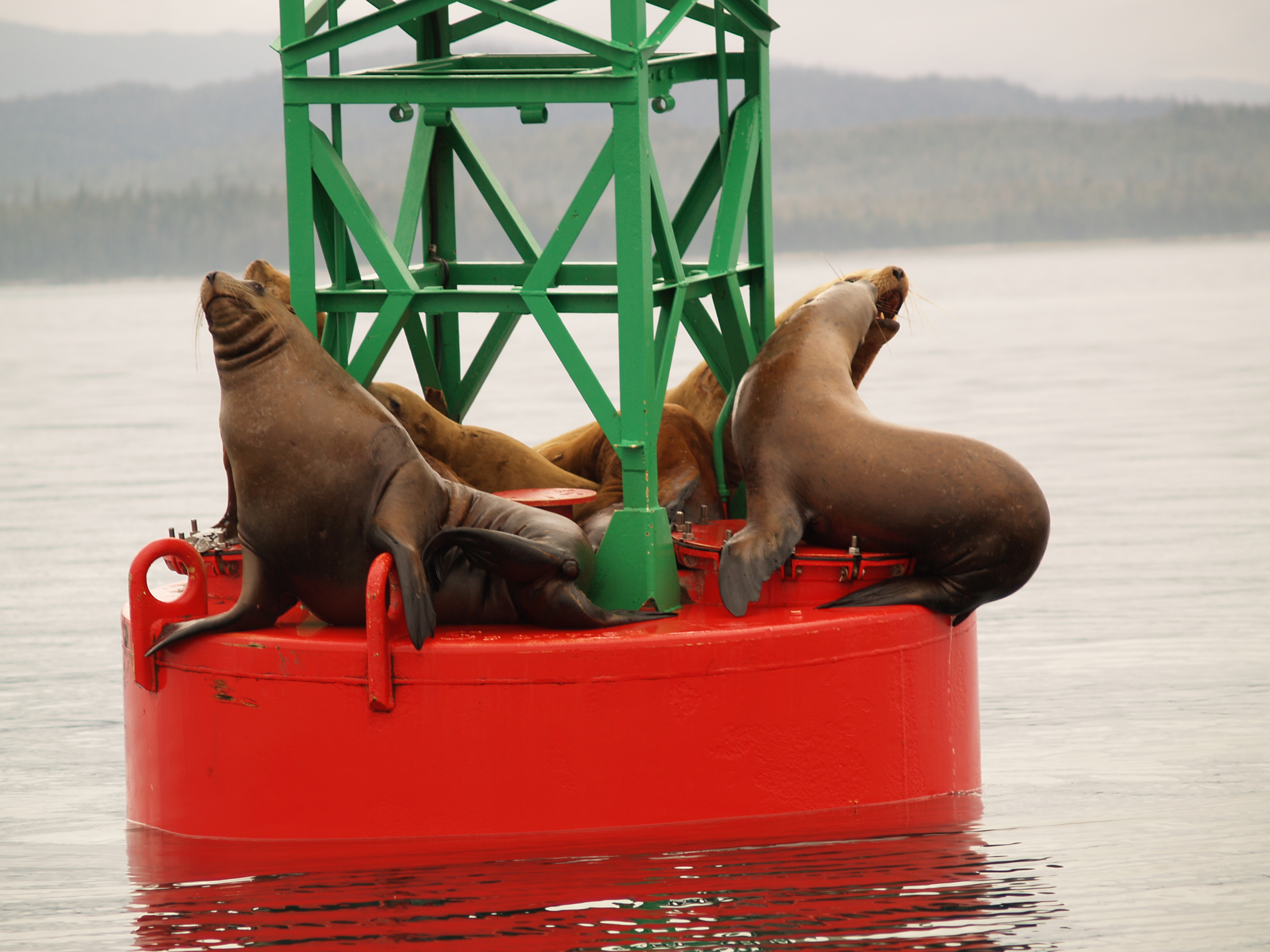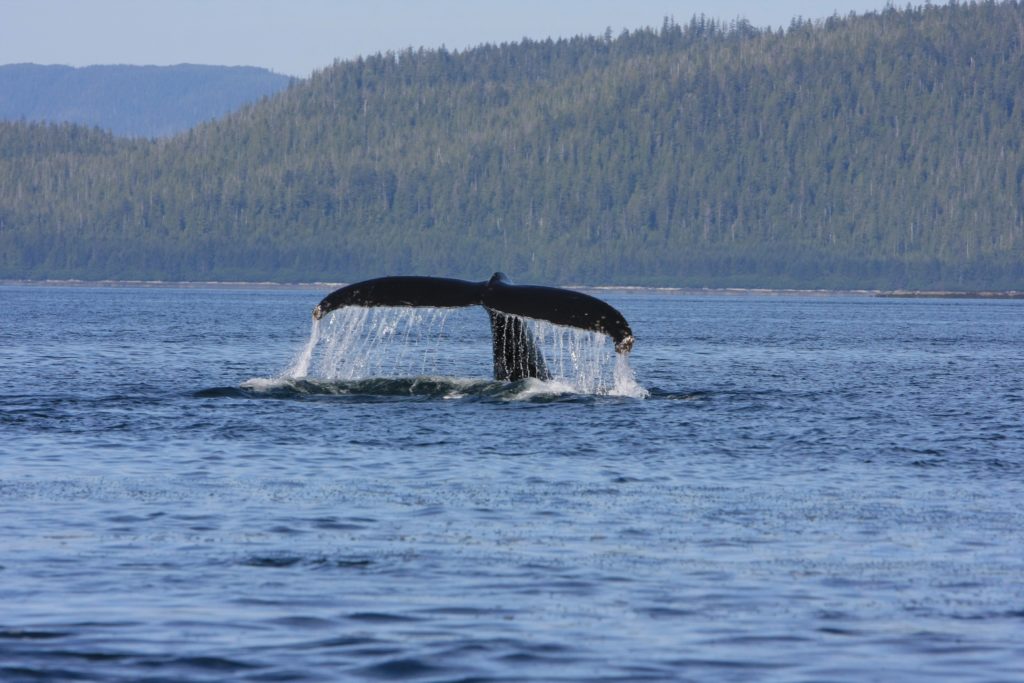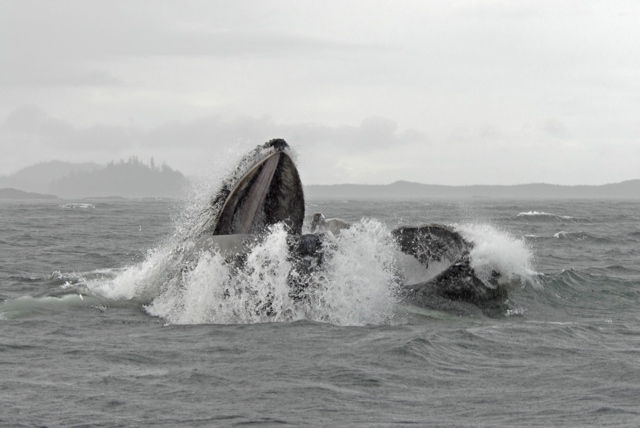
The nutrient rich waters of Southeast Alaska offer unprecedented opportunities to get up close and personal with whales and other marine animals in their native habitats. Tour the scenic waters surrounding Prince of Wales Island searching for humpback whales and orca. We’ll find them swimming, bubble net feeding, breeching, spy hopping and tail and fin slapping. The occasional siting of migrating minke, Northern right, gray, and beluga whales adds to the anticipation.
Seals, stellar and northern fur sea lions, porpoise and sea otters are also plentiful and commonly observed; you will get within a safe, close distance of these creatures and observe their behavior. Harbor seals abound. Colossal sea lions bark menacingly from their haul outs. Playful sea otters navigate the shallow, kelp-rich shorelines cracking shellfish and carrying their young on their chests. Dall and harbor porpoise can be seen skirting through the water, spooked by the bow waves.
 The baleen humpback whale is our most common sighting with views of blows, tails, fins and breaches accompanying most of our boat-based adventures. They are distinguished from other whales by the extremely long flippers which may reach 25 to 30 percent of the length of the entire animal, often seen wave above the water, which slap down repeatedly with thunderous claps.
The baleen humpback whale is our most common sighting with views of blows, tails, fins and breaches accompanying most of our boat-based adventures. They are distinguished from other whales by the extremely long flippers which may reach 25 to 30 percent of the length of the entire animal, often seen wave above the water, which slap down repeatedly with thunderous claps.
These graceful giants, nearing 60 feet in length and almost 50 tons in weight, will appear suddenly, feeding and lolling at the surface for extended periods of time and just as suddenly wave a fluke and dive for periods of 15 to 30 minutes. When resting near the surface, the whales may blow every few seconds. It is not uncommon for a humpback whale to live for 45 to 50 years, with the oldest recorded age nearing 90 years.
 Our humpbacks winter primarily in Hawaii, where they mate and calve. They make the 2,800-mile return trip annually to gorge on the abundant food in Alaska. The humpbacks tend to congregate in the most nutrient rich waters, including Clarence Straight, just outside the passage to our lodge. They feed principally on herring, other small schooling fish, and on swarms of krill. These whales use a variety of feeding behaviors to catch food including underwater exhalation of columns of bubbles that concentrate prey, feeding in formation, herding of prey, and lunge feeding. The significance of the summer songs of the humpback are believed to be related to feeding activities.
Our humpbacks winter primarily in Hawaii, where they mate and calve. They make the 2,800-mile return trip annually to gorge on the abundant food in Alaska. The humpbacks tend to congregate in the most nutrient rich waters, including Clarence Straight, just outside the passage to our lodge. They feed principally on herring, other small schooling fish, and on swarms of krill. These whales use a variety of feeding behaviors to catch food including underwater exhalation of columns of bubbles that concentrate prey, feeding in formation, herding of prey, and lunge feeding. The significance of the summer songs of the humpback are believed to be related to feeding activities.
Orcas, the largest members of the dolphin family, are called killer whales because they attack and consume whales or other large prey such as seals and sea lions. Weighing in at an average of six tons and growing to nearly 27 feet, these marine mammals display significant individuality in their black and white coloring. The very tall dorsal fin is characteristic of this species, with the males often towering nearly 6 feet in height. Most Alaskan pods are 40 or fewer and are very stable in membership, consisting of a female and her offspring of both sexes. We see some pods throughout much of the summer , such groups being referred to as “resident” pods. Others, referred to as “transient” pods, are just passing through. Killer whales are quite vocal, with each pod having its own unique, recognizable type of calls which do not change over periods of as long as 25 years. The lifespan of an individual orca averages 30 years, though they have been known to live to over 50 and even 60 years old.
Whales & Marine Life
Opportunity to tell user what they will find here.

